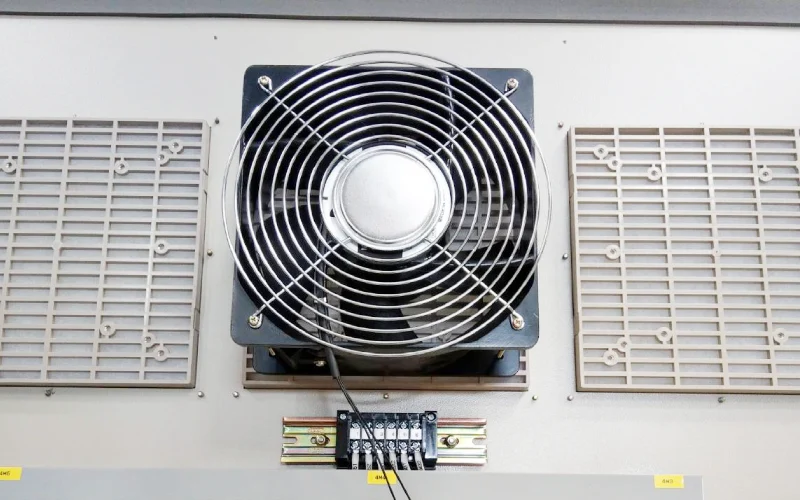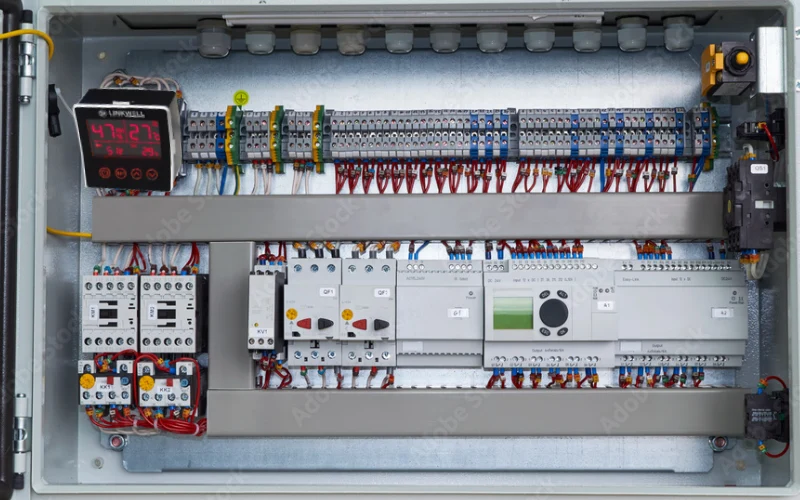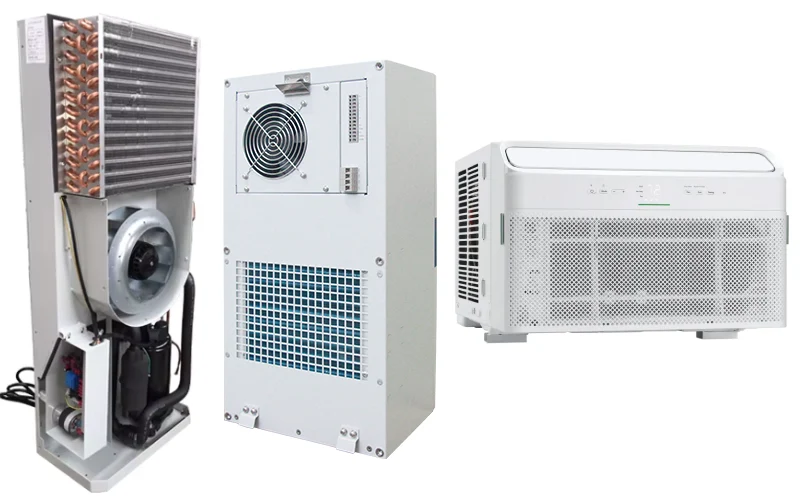When you look at how circuit breaker switches work with power distribution blocks, you see a system that keeps your home or business safe and efficient. Circuit breakers act as your first defense against electrical problems like overloads or short circuits. If these parts fail, the risk of fire and injury goes up.
- Many electrical faults, especially from failing circuit breakers, can cause fires.
- Integration with power distribution blocks helps isolate circuits for safe maintenance and boosts overall safety.
Linkwell provides trusted solutions that help you avoid these risks and make installation easier for both homeowners and professionals.
Key Takeaways
- Circuit breakers protect your home or business from electrical overloads and short circuits, reducing the risk of fires and injuries.
- Power distribution blocks organize and manage multiple circuits, making it easy to expand your electrical system without major rewiring.
- Regular maintenance of circuit breakers and distribution boards is essential for safety; inspect them at least once a year to ensure they function properly.
- Choosing certified products like Linkwell ensures your electrical system meets safety standards, providing peace of mind and reliable performance.
- Incorporating advanced features like ground fault protection and arc fault detection enhances safety and efficiency in your electrical setup.
How Circuit Breaker Switches Work with Power Distribution Blocks
Circuit Breakers in Power Distribution
You probably know that the main switch in your electrical system is the circuit breaker. This device stands guard over your circuits, ready to cut off power if something goes wrong. When you flip a switch or plug in a device, the circuit breaker quietly monitors the flow of electricity. If the current gets too high, the breaker trips and disconnects the main circuit. This action keeps your home or business safe from fires and electrical damage.
Here’s a quick look at what circuit breakers do in a power distribution system:
| Function | Description |
|---|---|
| Preventing Overheating | Circuit breakers cut off power to prevent wires from overheating, which can lead to fires. |
| Guarding Against Short Circuits | They detect short circuits and interrupt the current to prevent dangerous situations. |
| Arc Fault Protection | Advanced breakers detect electrical arcs and trip the circuit to prevent fire hazards. |
| Ground Fault Protection | GFCIs shut off power when they detect ground faults, preventing electrical shocks and fires. |
You might wonder how circuit breaker switches actually detect problems. They use several smart mechanisms:
- Thermal detection uses a bimetallic strip that bends when it gets hot from too much current.
- Electromagnetic detection relies on coils that react to sudden changes in current flow.
- Microprocessor-based detection gives advanced circuit breakers the ability to monitor current levels all the time.
When you use a main switch with these features, you get a system that reacts fast to any electrical fault. This means your circuits stay protected, and your power stays reliable.
Power Distribution Block Function
Now, let’s talk about the power distribution block. This component acts as the main hub for your electrical system. It takes the main power feed and splits it into several circuits. Each circuit can then be protected by its own breaker switch. This setup keeps your wiring organized and makes it easy to manage multiple circuits.
A power distribution block does more than just split power. It also keeps your system safe and efficient. Here’s how:
| Feature | Description |
|---|---|
| Safety | Achieves IP20 level of finger safe protection, so you don’t need special covers. |
| Installation | Snap-on design lets you install it quickly on a 35mm DIN rail. |
| Versatility | Modular design means you can add as many poles as you need. |
| Functionality | Lets you splice cables safely, split main power into secondary circuits, and create tap-off points. |
Modern circuit breaker switches and power distribution blocks improve energy efficiency by enabling faster response times and reducing energy losses. For example, semiconductor-based circuit breakers can operate much faster than traditional switches, which is important for managing direct current (DC) systems. DC systems lose less energy during transmission, making your setup even more efficient.
When you combine a main switch with a power distribution block, you get a system that’s easy to expand and maintain. You can add new circuits or upgrade your main switch without rewiring the whole panel. This flexibility saves you time and money.
Linkwell’s Role in Electrical Safety
You want your electrical system to be safe and reliable. That’s where Linkwell comes in. Linkwell’s circuit breaker switches and power distribution blocks meet strict UL and IEC standards. You get secure, insulated connections, overload protection, and finger-safe designs. These features help prevent accidents and keep your circuits running smoothly.
Here’s how Linkwell’s products stack up in real-world projects:
| Metric | Before Upgrade | After Upgrade |
|---|---|---|
| Downtime incidents/month | 3.4 | 0.5 |
| Component failure rate | 12% annually | <3% annually |
| Mean Time Between Failures | 9 months | 27 months |
- In over 300 telecom projects, customers saw up to 80% fewer failures after switching to Linkwell.
- Energy companies reported an 80% drop in equipment failures after installing Linkwell’s enclosure heaters.
Linkwell’s main switches and power distribution blocks use modular structures, so you can scale your system as your needs grow. You also get smart features like real-time diagnostics and remote monitoring. These advancements help you spot problems before they cause downtime.
When you choose Linkwell, you get more than just parts. You get a partner who helps you build a safer, more efficient electrical system. You can trust their main switch and power distribution block solutions to keep your circuits protected and your power flowing.
Main Components in Power Distribution Box
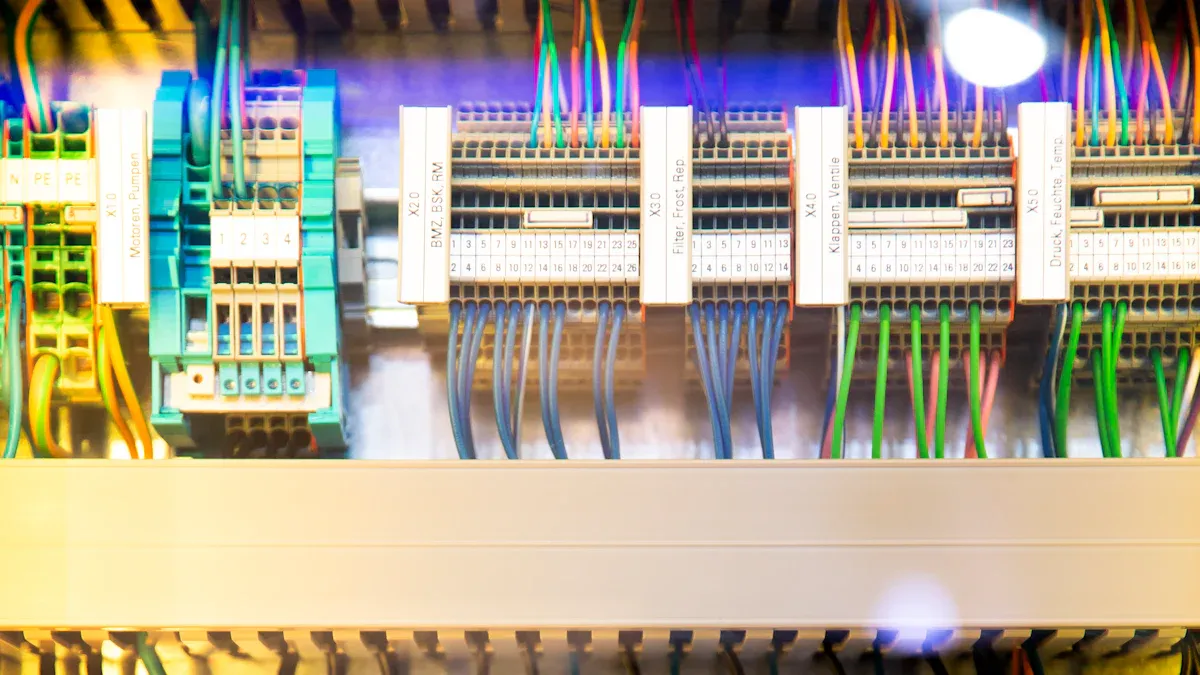
Busbars and Wiring
When you open a power distribution box, you see a network of busbars and wiring. Busbars look like thick metal strips. They act as the main highway for electric current, moving power from the main switch to all the circuits. Their wide, flat design lets them carry large amounts of power with very little energy loss. You get better efficiency compared to bundles of thin wires.
Wiring connects each circuit breaker to the busbar and then to the individual circuits. Power distribution boards use organized wiring to keep everything safe and easy to manage. Breakers and fuses protect each circuit from overloads and faults. You want a system that keeps cables neat and secure. Qualified electricians install the distribution board vertically, with openings facing down to keep water out. Proper grounding is a top priority, and secure connections help prevent overheating.
Tip: Always test your GFCI receptacles before turning on the power. Monthly checks and cable inspections help you catch problems early.
Circuit Breakers and Distribution Blocks
Circuit breakers sit at the heart of every power distribution box. You rely on these breakers to protect your circuits from overloads and faults. Each circuit breaker connects to a specific circuit, ready to trip if the current gets too high. The main switch controls the flow of power into the distribution board, acting as your first line of defense.
Distribution blocks split the main power feed into several circuits. You get a modular setup that makes it easy to add new circuits or upgrade your system. When you combine circuit breakers and distribution blocks, you create a system that’s safe, flexible, and easy to expand. You can isolate circuits for maintenance without shutting down the whole board.
Here’s a quick look at the benefits of a well-arranged power distribution box:
| Benefit | Explanation |
|---|---|
| Better Safety | Protects against overloads, short circuits, and electrical fires using circuit breakers and fuses. |
| Efficient Power Use | Spreads power evenly across circuits to prevent overloads and improve energy efficiency. |
| Easy to Manage | Centralized control allows for easy management of power distribution without shutting down the system. |
| Good for Growing Systems | Modular design enables future expansion without starting over, accommodating growing needs. |
Linkwell Power Distribution Box Features
You want a power distribution box that meets strict safety standards. Linkwell’s boxes come with certifications like IEC 61439, UL 508A, ISO 9001, CE marking, and RoHS compliance. These certifications mean you get a product that’s safe, reliable, and built to last.
Linkwell designs its power distribution boards with features that make installation and maintenance simple. You get durable enclosures that protect internal components from damage. Indication lights show the status of the main power supply. Circuit breakers, RCCBs, isolators, busbars, neutral links, and grounding busbars all work together to keep your circuits safe.
When you install a Linkwell power distribution box, you follow best practices for circuit protection. Inspect the panel, turn off the power, and test for voltage before installation. Always size your circuit breaker for the load, and make sure wiring connections are secure. After setup, test everything to confirm safety and functionality.
Note: Linkwell’s modular design lets you expand your system as your needs grow. You get a solution that’s ready for the future.
Electrical Safety and Protection
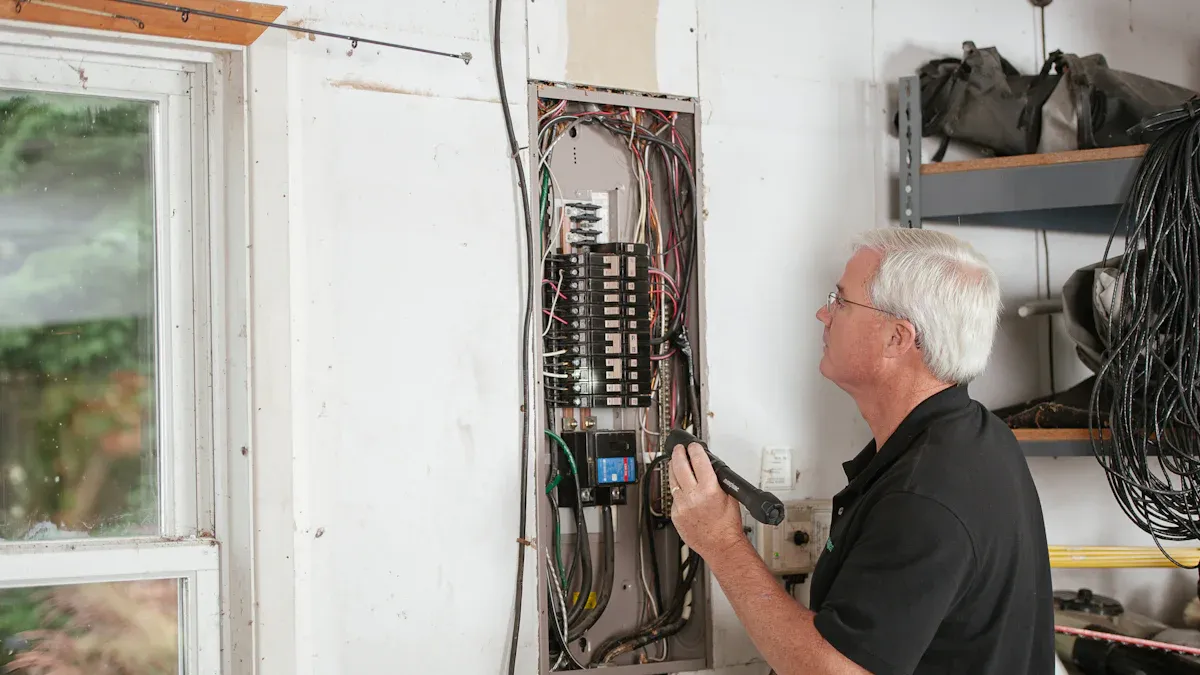
Overload and Short Circuit Protection
You want your electrical system to work safely every day. Circuit breakers and power distribution blocks play a big role in electrical safety. When you use a distribution board, you get a setup that protects your home or business from overloads and short circuits. Circuit breakers watch the current in each circuit. If the current gets too high, the breaker trips and cuts the power. This stops wires from overheating and lowers the risk of fire.
Circuit breakers and breakers in the main distribution board work together with surge protection devices and residual current devices. These devices give you extra protection against electrical faults. Surge protection devices guard your system from sudden spikes in power. Residual current devices shut off the circuit if they sense a dangerous leak of current, keeping you safe from shocks.
Here’s a quick look at how different breakers protect your system:
| Mechanism Type | Description |
|---|---|
| Thermal Circuit Breakers | Use heat to trip and break the circuit during overloads. |
| Magnetic Circuit Breakers | Use magnets to react quickly to short circuits. |
| Thermal Magnetic Circuit Breakers | Combine both methods for better protection. |
| Ground Fault Circuit Interrupters | Cut power if they detect a ground fault. |
| Arc Fault Circuit Interrupters | Stop the circuit if they sense dangerous arcs. |
| Molded Case Circuit Breakers | Offer strong protection for main power lines. |
Standards and Certifications
You should always look for products that meet top safety standards. Linkwell’s circuit breakers, distribution boards, and surge protection devices carry IEC and UL certifications. These certifications mean your equipment meets strict international rules for electrical safety and performance.
- IEC Certification: This shows your breakers and distribution board meet global safety and performance standards.
- UL Certification: This means your main power protection devices have passed tough third-party safety tests.
Linkwell’s products, like their main distribution board and surge protection devices, also have CE and RoHS marks. You get peace of mind knowing your system uses certified parts.
Maintenance Tips
You can keep your electrical safety strong with regular care. Check your distribution board, circuit breakers, and surge protection devices at least once a year. For older systems, get a professional to inspect every ten years. Clean your main power panel and look for signs of wear or damage. Test your residual current devices and breakers to make sure they trip when needed.
Here’s a simple maintenance schedule:
| Maintenance Task | Frequency |
|---|---|
| Visual & Mechanical Inspection | Regularly |
| Test circuit breakers and surge protection devices | Every 6-12 months |
| Clean distribution board and main panel | Annually |
| Professional inspection for older systems | Every 10 years |
Tip: Always follow the manufacturer’s instructions and use trained professionals for repairs. Well-maintained circuit breakers and distribution boards respond faster to problems, giving you better protection and electrical safety.
You get a safer, more efficient electrical system when you pair circuit breaker switches with power distribution blocks. Certified products like Linkwell offer compact size, selective tripping, and reliable performance. If you plan an upgrade, follow safety steps and label every circuit. Avoid loose wiring and overcrowded panels. For complex projects, talk to a licensed electrician. They help you meet safety codes and spot outdated wiring. Regular inspections keep your system running smoothly. 🛠️
FAQ
What’s the main job of breakers in my power distribution box?
Breakers protect your circuits from overloads and short circuits. You get peace of mind knowing your system will shut off power before wires overheat or cause a fire.
How do I know if I need a ground fault circuit interrupter?
You need a ground fault circuit interrupter in areas with water, like bathrooms or kitchens. It helps you avoid electric shocks by shutting off power when it senses a ground fault.
Can I add more circuits to my distribution box later?
Yes, you can expand your system. You just need to install extra breakers and connect them to your power distribution block. This setup makes upgrades easy.
How often should I check my breakers and distribution box?
You should inspect your breakers and distribution box every year. Look for signs of wear, loose wires, or tripped breakers. Regular checks keep your system safe.

